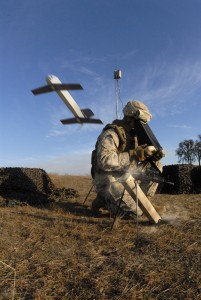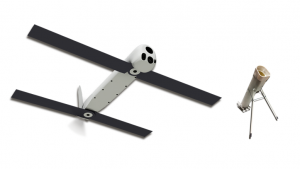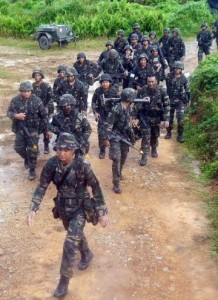SHAH ALAM: MUCH of the focus of the Armed Forces are now towards the increasing the size, lethality and firepower of the Army. Though I – as an armchair observer – regard up-sizing the Army as a step in the wrong direction (and expensive), I cannot but help offer a pointer or two on the latter objectives for those in the planning department or business development divisions (if they are reading this of course).
As for boosting the lethality and firepower, I heartily agree to any efforts to do so though I do not think the mini-guns will actually do so. In fact, any additional lethality and firepower should be prioritised to the mainstay of the Army – the RMR and RRR battalions.
I believed one of the ways is to issue man-packable loitering munition together with portable drones for ISR at the platoon level. Yes, there are other means to boost the lethality and firepower of a rifle platoon but the portable drone is powerful enough (for its size) and light enough for the average 60-kg soldier to carry on their backs without reducing their effectiveness.


Furthermore, if it could be useful to the rifle platoon , it would also do the same for Special Forces operators. Such small drones could also be carried and fired from patrol boats to target anything carrying terrorists or pirates. Its like having your own Close-Air Support without the hassle of contacting attack helicopters or the air force and the complexities of such close co-ordination entails.

Launching the portable drone in a dense jungle could be problematic, I must admit, though. However, as our soldiers are expected to fight in all sorts of environment nowdays, I am pretty sure our soldiers could make full use of the portable drones after undergoing extensive training on them. Which is likely to be less time consuming and less expensive than training for CAS (though it may yet be necessary).

Yes, a single portable drone could cost RM1 million per example but its cheaper than the lives of our soldiers. Of course, mortar rounds are cheaper but the rifle platoon could carry several 60mm mortar as well as the loitering munition by spreading them down the line. Though its still a ….I must admit to carry more things on your back.
According to an article at Defence Tech there are various loitering munition platforms readily available for procurement to meet UOR. More importantly, it appears that unlike armed UAVs, loitering munitions do not have any extensive export restrictions.
“In the U.S., the Lethal Miniature Aerial Munition System is only progressing slowly towards becoming a program of record. This is in spite of the successes achieved by the successful fielding of Switchblade drones under the program.
Made by AeroVironment Inc., the Switchblade weighs less than five pounds and its electric propulsion is near-silent. It is tube-launched, with flick-out wings, and can fly for more than ten minutes, sending back color video and infra-red imagery so the operator can locate and identify a target. Once spotted, it can lock on and dive in at over 90mph with a warhead powerful enough to take out a pickup truck or a group of individuals with pinpoint precision from six miles away.
Apart from the Switchblade there are other loitering munition platforms available from at least two other US companies. If buying from the US is not preferred, there are also options from Poland and Iran (yes, the Israelis also made them and probably China too) as stated by the Defense Tech article.
The Polish product, Warmate from WB Electronics, is interesting as a soldier in the field could change the payloads from an ISR equipment to HEAT warhead for vehicles or HE for personnel. However, such capability comes with a price, it is much heavier compared lets say to the Switchblade.
From the pictures (above and below), the Warmate may be more suited to a mechanised rifle platoon. The company claimed it has sold the drone to an unnamed Asian customer though it is unlikely it was Malaysia.
What about building it on our own by simply modifying a commercial drone to carry a warhead or an ISR package as done by some people in the Middle East? Yes we could do that of course but not to the expense of waiting three or four years when our soldiers need every help they can right now. And it is less likely to be easily carried in the field.
I feel so strongly about this that perhaps I may just set up a company to lobby and sell these devices to the Army, like how others did for a lot of stuff of the Armed Forces (though I must admit I hate the idea of begging though the thought of driving a Panamera GTS is quite tempting).
By the way if you have an idea to boost the lethality and firepower of our light infantry units – not something that will be a hangar queen at brigade or divisional level – drop me an article on my email. I will use it as a guest post.
–Malaysian Defence
If you like this post, buy me an espresso. Paypal Payment
View Comments (11)
Hi. Personally i dont think equipping a rufle platoon with drones is cost-effective. Instead, drones shld be managed at company level instead of equipping platoons.
Secondly, Company or battalion hq is in a better state to monitor movements and deploy the necessary drones and lead the platoons to the locations. Let platoons focus on utility of firepower.
Thirdly, instead on drones, a platoon shld be equipped with other less heavy and cumbersome techs; IR, NGV googles, body armour, and cameras.
Cheers
With due respect, there is only limited use of drones by the standard battalions. This is due to the geographical limitations of the country. I would rather they improve the infantry firepower . How can this be done?. Its as simple as giving each section an additional saw or a RPG. Even mortars has limited usage in a jungle environment. Remember the time when we scored our own goal when trying to fire a mortar through the trees. The bomb hitting a branch n falling amoung the men. A no no. So direct fire weapon is best. Moreover control would be an issue. As radio frequencies may not reach or clear a valley
A loitering drone cannot vote for BN, unlike strategically located additional army units...
Reply
You said it, not me...
Direct fire weapons are dependent on the terrain. Firepower is not a panacea; it has to be used in combination with right tactics, unit cohesion, good tactics, good leadership, superior SA and maneuver....... As it is, the sections in in the BIS units are weighed down; increasing their "firepower" leads to more things to carry and a heavier ammo usage. No point having extra "firepower" if we can't restock the units with ammo in time (especially in a high intensity conflict which we have no experience of) and if the men can hardly move because of the extra weight.
All of your infantry can be considered as "light", after restructuring thst saw a section is reduced to 8 man (instead of a dozen during insurgency era)
If anything, I would think that a designated marksman team (armed with semi auto DM gun) that is organic to the platoon could increase the firepower of a platoon. Not as useful in the jungle, but in FIBUA, it could prove significant
Incresing fire power by way of direct fire weapons is the easiest n best way. Of course correct tactics n trainning are all important n that is a continuing thing. But nothing beats one more saw n RPG. Great especially when pun down by superior firepower.
Lee,
Fine on paper but in reality someone has to carry that extra SAW and RPG and both have to be resupplied with ammo. As it is, the BIS infantry sections already have a lot to carry : 1 LMG, 1 Milkor, 1 shoulder launched weapon and M-4s, as well as all the other stuff including ammo, spare batteries, etc (that does not include the 60mm mortars that are organic to a section!).
We need to revamp the way we do things and have a look at our organisation and doctrine. Increasing firepower does not solve anything; if anything, it might create more problems for sections that are already short of people and have more than enough to lug.
I say. The same n a larger load cwas lugged by us during the emergency days. Count themselves lucky. During my time a lmg is a converted bren that fires 7.62mm. Rifles were the long n heavy slr. Mortars are not brought along everytime but if does everyone helps to carry. Now how much does a saw weight?. 5.56mm ammo is very light. Actually claymores are better firepower to bring along. Milkor is light n its ammo is light too. The grenades look huge but actually very light.
The saw now is also light by comparison.
So our men can carry them. No problem actually. If the soldiers duribg 2nd emergency days can do it how come our soldiers cant do it now?. Reduced manpower?. Who said that an infantry section last time is fully manned?. Soldiers retire, on medical goes for training etc. So the infantry is never ever fully manned at any one time. Its not new. We managed last time. So let them manage now.
Lee - ''The same n a larger load cwas lugged by us during the emergency days''
I say. You chaps carried more stuff but this is also because it also included rations. You guys had 'x' number of square map miles to patrol and had to have enough rations to be self sustaining for a certain period. The key difference now is that infantry sections carry much more ''firepower'' than sections did during the Emergency.
Lee - ''the same n a larger load cwas lugged by us during the emergency days.
Firstly, during the Emergency troops did not carry as much ammo as troops engaged in high tempo ops would. Secondly, on an operational level, circumstances encountered in a future conflict would be slightly different from the Emergency. Troops engaged in high temp ops would need much larger amounts of ammo for the simple reason that ammo usage would be higher.
Lee - ''Who said that an infantry section last time is fully manned?. ''
You're shooting the wrong calibre .....
My reference to small section was because the BIS sections only have 8 men. Adding another LMG would mean that one of those 8 men would have something else to carry. As it is the BIS sections already have an LMG, a Milkor and a shoulder fired weapon; that does not include comms, belt order, helmets and other gear.That then leaves just 5 men - including the section leader - who are dedicated riflemen. BTW, the reason we have understrength sections is because these sections have to fit in an Adnan - other armies also face the same problem in that the size of sections are dictated by the number of men that can be practically carried in the cabin of an APC/IFV; which incidently will also be carrying other gear onboard such as spare ammo, bergens, etc.
Lee - ''We managed last time. So let them manage now.''
Times are different now - we can't simple assume that what worked during the Emergency will work now. A lot of the lessons learnt during the Emergency are still valid now but many aren't for the simple reason that we now face a different king of enemy and will conduct ops in a different kind of terrain compared to during the Emergency. During the Emergency a main problem was locating the enemy and fixing him. In a future conflict the enemy will be more in the open will be better armed and supplied compared to Chin Peng's goons.
Lee - '' Milkor is light n its ammo is light too.''
The Milkor operator also carries an M-4 and his belt order kit. The ammo may be ''light'' as you say but enough has to be carried based on a calculated usage rate.
Lee - ''Actually claymores are better firepower to bring along.''
Claymores are great when operating from defended positions or mounting ambushes BUT are not so great when constantly on the move or when one is engaged in a war of maneuver .......
I am not convinced. I will stick to my guns while you can stick to your flying bombs ya